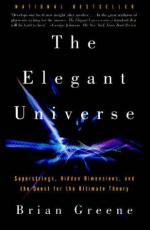
|
| Name: _________________________ | Period: ___________________ |
This test consists of 15 multiple choice questions and 5 short answer questions.
Multiple Choice Questions
1. What is supergravity?
(a) A combination of general relativity and supersymmetry.
(b) The relativistic effect of two particles occupying the same location.
(c) The gravitational conditions inside a black hole.
(d) The gravitational force felt at the Planck scale.
2. Which of the following is true regarding our current knowledge of the Calabi-Yau space?
(a) Its shape is completely known and defined.
(b) Its shape is not fully known.
(c) Its shape is totally unknown.
(d) Physicists and mathematicians disagree about its shape.
3. What materials were formed during the period of the big bang known as the "primordial nucleosynthesis"?
(a) Up, down, top, and bottom quarks.
(b) Hydrogen and helium nuclei.
(c) Anti-matter particles.
(d) Neutrons.
4. How does the shape of the extra "curled up" dimensions affect the vibration of strings?
(a) Only the wavelength of the vibration is affected.
(b) Only the total energy of the vibration is affected.
(c) The shape does not affect the vibrational patterns.
(d) The shape determines what types of vibrations are possible.
5. In what important way does string theory affect the cosmological model of the big bang?
(a) The big bang could have created multiple universes.
(b) The big bang created strings, not particles.
(c) The universe is infinite, but has no boundaries.
(d) The universe started at a certain minimum size.
6. Kaluza-Klein theory units which two fundamental forces?
(a) Electromagnetism and the weak force.
(b) Gravity and the strong force.
(c) Gravity and electromagnetism.
(d) The strong force and the weak force.
7. Greene suggests that black holes may be elementary particles that have undergone _____.
(a) A phase transition.
(b) A quantum fluctuation.
(c) A mirror-symmetry folding.
(d) A space-tearing flop transition.
8. What is one of the difficulties in determining the shape of the Calabi-Yau space?
(a) The equations governing its shape are too complex.
(b) The shape has an unequal number of real and imaginary dimensions.
(c) There are an infinite number of unknowns in its governing equation.
(d) No field of mathematics exists to support it.
9. Which of the following is true regarding the force of gravity in string theory?
(a) String theory predicts gravity.
(b) Gravity is not addressed in string theory.
(c) Gravity in string theory acts over much longer distances.
(d) Gravity in string theory is stronger than what we actually observe.
10. What is the collapse and reformation of a Calabi-Yau shape called?
(a) A conifold transition.
(b) A manifold transition.
(c) A space-tearing flop transition.
(d) A binary transition.
11. Kaluza's theory suggested that electromagnetism was carried by ripples in _____.
(a) The time-dimension only.
(b) The three normal space dimensions.
(c) All dimensions of both space and time.
(d) The "curled up" dimensions.
12. Riemannian geometry describes the following objects: _____.
(a) Six-dimensional manifolds.
(b) Finite, unbounded spaces.
(c) N-dimensional spheres.
(d) Curved spaces.
13. Which of the following best describes the fate of Kaluza-Klein theory?
(a) It became widespread for a short time, but receives almost no attention now.
(b) It became the mathematical basis of general relativity.
(c) It was updated through the 1970s, and eventually incorporated into string theory.
(d) It was quickly discarded as meaningless, but rediscovered by string theory.
14. How many dimensions are necessitated by M-theory?
(a) Eight.
(b) Ten.
(c) Eleven.
(d) Nine.
15. What does the string coupling constant govern?
(a) The likelihood of strings joining or separating.
(b) The number of strings that can be joined at once.
(c) The relative length of threading between strings.
(d) The strength of links between strings.
Short Answer Questions
1. What distinction does dark matter have?
2. By what factor is the minimum mass of a wrapped string in determined?
3. What problem of cosmology was the inflationary model created to deal with?
4. What is the traditional method of testing theories in physics?
5. Tears in space-time are technically termed _____.
|
This section contains 666 words (approx. 3 pages at 300 words per page) |

|




